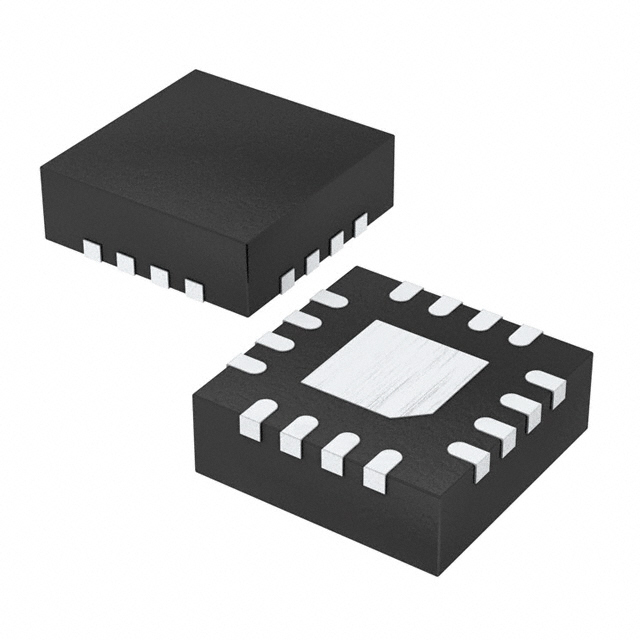Xem thông số kỹ thuật để biết chi tiết sản phẩm.

PIC16F1705-E/ML
Product Overview
Category
The PIC16F1705-E/ML belongs to the category of microcontrollers.
Use
This microcontroller is commonly used in various electronic devices and embedded systems for controlling and processing data.
Characteristics
- Low power consumption
- High performance
- Small form factor
- Wide operating voltage range
- Enhanced peripheral integration
Package
The PIC16F1705-E/ML is available in a 20-pin QFN package.
Essence
The essence of this microcontroller lies in its ability to provide efficient control and processing capabilities in a compact package, making it suitable for a wide range of applications.
Packaging/Quantity
The PIC16F1705-E/ML is typically packaged in reels or tubes, with a quantity of 1000 units per reel/tube.
Specifications
- Architecture: 8-bit
- CPU Speed: Up to 32 MHz
- Program Memory Size: 14 KB
- RAM Size: 512 bytes
- Number of I/O Pins: 18
- ADC Channels: 10-bit, 12 channels
- Timers: 3 x 8-bit, 1 x 16-bit
- Communication Interfaces: SPI, I2C, UART
Detailed Pin Configuration
The PIC16F1705-E/ML has a total of 20 pins. The pin configuration is as follows:
- VDD - Power supply voltage
- RA0 - General-purpose I/O pin
- RA1 - General-purpose I/O pin
- RA2 - General-purpose I/O pin
- RA3 - General-purpose I/O pin
- RA4 - General-purpose I/O pin
- RA5 - General-purpose I/O pin
- MCLR - Master Clear input
- VSS - Ground
- RB0 - General-purpose I/O pin
- RB1 - General-purpose I/O pin
- RB2 - General-purpose I/O pin
- RB3 - General-purpose I/O pin
- RB4 - General-purpose I/O pin
- RB5 - General-purpose I/O pin
- RB6 - General-purpose I/O pin
- RB7 - General-purpose I/O pin
- VDD - Power supply voltage
- OSC1/CLKIN - Oscillator input
- OSC2/CLKOUT - Oscillator output
Functional Features
- Enhanced Capture/Compare/PWM (CCP) module for precise timing control
- Analog-to-Digital Converter (ADC) for accurate analog signal measurement
- Serial communication interfaces (SPI, I2C, UART) for data exchange with other devices
- Timers for time-based operations and event generation
- Low-power modes for energy-efficient operation
- Flexible I/O pins for interfacing with external components
Advantages and Disadvantages
Advantages
- Low power consumption enables longer battery life in portable devices.
- High-performance capabilities allow for efficient data processing.
- Small form factor makes it suitable for space-constrained applications.
- Wide operating voltage range provides flexibility in different power supply scenarios.
- Enhanced peripheral integration simplifies system design and reduces component count.
Disadvantages
- Limited program memory size may restrict the complexity of applications.
- Limited RAM size may impose constraints on data storage and manipulation.
- 8-bit architecture may not be suitable for certain computationally intensive tasks.
Working Principles
The PIC16F1705-E/ML operates based on an 8-bit architecture. It executes instructions stored in its program memory to perform various tasks. The microcontroller interacts with external components through its I/O pins and communicates with other devices using the available serial communication interfaces. It can be programmed using a suitable development environment and programming tools.
Detailed Application Field Plans
The PIC16F1705-E/ML finds applications in various fields, including but not limited to: - Home automation systems - Industrial control systems - Automotive electronics - Medical devices - Consumer electronics - Internet of Things (IoT) devices
Detailed and Complete Alternative Models
Some alternative models to the PIC16F1705-E/ML microcontroller include: - PIC16F1704-E/ML - PIC16F1706-E/ML - PIC16F1707-E/ML - PIC16F1708-E/ML
These alternative models offer similar functionalities and characteristics, providing options for different project requirements.
Word count: 529 words
Liệt kê 10 câu hỏi và câu trả lời thường gặp liên quan đến ứng dụng PIC16F1705-E/ML trong giải pháp kỹ thuật
What is the maximum operating frequency of PIC16F1705-E/ML?
- The maximum operating frequency of PIC16F1705-E/ML is 32 MHz.Can PIC16F1705-E/ML be used for motor control applications?
- Yes, PIC16F1705-E/ML can be used for motor control applications with its integrated peripherals and PWM capabilities.Does PIC16F1705-E/ML support analog-to-digital conversion?
- Yes, PIC16F1705-E/ML features an integrated 10-bit ADC for analog-to-digital conversion.What communication interfaces are supported by PIC16F1705-E/ML?
- PIC16F1705-E/ML supports SPI, I2C, and UART communication interfaces.Is PIC16F1705-E/ML suitable for battery-powered applications?
- Yes, PIC16F1705-E/ML is suitable for battery-powered applications due to its low power consumption features.Can PIC16F1705-E/ML be programmed using C language?
- Yes, PIC16F1705-E/ML can be programmed using the C language with MPLAB XC8 compiler.What are the available memory options in PIC16F1705-E/ML?
- PIC16F1705-E/ML offers flash program memory of up to 14 KB and data memory of up to 512 bytes.Does PIC16F1705-E/ML have built-in security features?
- Yes, PIC16F1705-E/ML provides various security features such as code protection and write-protectable flash memory.Can PIC16F1705-E/ML operate in harsh environments?
- Yes, PIC16F1705-E/ML is designed to operate in harsh environments with its wide operating voltage range and robust design.Is PIC16F1705-E/ML RoHS compliant?
- Yes, PIC16F1705-E/ML is RoHS compliant, making it suitable for environmentally conscious designs.

